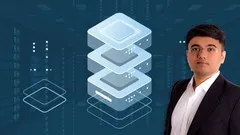
Executing Graph Algorithms with GraphFrames on Databricks 
In this course, you will learn how to use GraphFrames in Apache Spark to create and represent graph data, and apply graph algorithms such as Shortest Path and PageRank on Azure Databricks. ▼
ADVERTISEMENT
Course Feature
![]() Cost:
Cost:
Free Trial
![]() Provider:
Provider:
Pluralsight
![]() Certificate:
Certificate:
Paid Certification
![]() Language:
Language:
English
![]() Start Date:
Start Date:
On-Demand
Course Overview
❗The content presented here is sourced directly from Pluralsight platform. For comprehensive course details, including enrollment information, simply click on the 'Go to class' link on our website.
Updated in [April 29th, 2023]
What does this course tell?
(Please note that the following overview content is from the original platform)
This course will teach you how to create and represent graph data using GraphFrames in Apache Spark and implement graph algorithms such as Shortest Path and PageRank on Azure Databricks.
The Spark unified analytics engine is one of the most popular frameworks for big data analytics and processing. The GraphFrames package in Apache Spark allows you to represent graphs using a DataFrame-based API. GraphFrames also supports a number of graph algorithms such as Shortest Path, PageRank, Breadth-first search, and connected components. In this course, Executing Graph Algorithms with GraphFrames on Databricks, you will explore how graphs can be used to model entities and relationships in the real world. First, you will learn about the different kinds of graphs such as directed and undirected graphs, weighted and unweighted graphs. Then, you will discover how graphs can be represented using the GraphFrames API in Apache Spark and how you can compute the properties of a graph such as indegree and outdegree of a vertex and perform filtering operations on vertices and edges. Next, you will see how you can perform motif searches using GraphFrames in order to detect structural patterns in the graph. After that, you will learn how to use a domain-specific language for motif finding and run stateless and stateful queries on simple as well as complex real-world graphs. Finally, you will explore the variety of graph algorithms supported by the GraphFrames API including Breadth-first search, Shortest Path, triangle count, connected and strongly connected components, and PageRank. When you are finished with this course, you will have the skills and knowledge of graph algorithms in Spark needed to implement graph algorithms using the GraphFrames API provided by Spark.
We consider the value of this course from multiple aspects, and finally summarize it for you from three aspects: personal skills, career development, and further study:
(Kindly be aware that our content is optimized by AI tools while also undergoing moderation carefully from our editorial staff.)
What skills and knowledge will you acquire during this course?
By taking this course, Executing Graph Algorithms with GraphFrames on Databricks, learners will acquire the skills and knowledge of graph algorithms in Spark needed to implement graph algorithms using the GraphFrames API provided by Spark. Learners will learn how to create and represent graph data using GraphFrames, compute the properties of a graph such as indegree and outdegree of a vertex, and perform filtering operations on vertices and edges. They will also learn how to perform motif searches using GraphFrames and use a domain-specific language for motif finding. Additionally, learners will explore the variety of graph algorithms supported by the GraphFrames API including Breadth-first search, Shortest Path, triangle count, connected and strongly connected components, and PageRank.
How does this course contribute to professional growth?
Executing Graph Algorithms with GraphFrames on Databricks provides learners with the opportunity to gain a comprehensive understanding of graph algorithms and how to implement them using the GraphFrames API in Apache Spark. This course is ideal for learners who are looking to gain the skills and knowledge of graph algorithms in Spark needed to analyze and process data in a variety of real-world applications. By taking this course, learners will be able to apply their knowledge to a variety of career paths, such as Data Scientist, Data Engineer, Machine Learning Engineer, and Big Data Architect. Additionally, learners can pursue further education in the field by obtaining a Bachelor's Degree in Computer Science, Master's Degree in Data Science, Master's Degree in Artificial Intelligence, or a PhD in Graph Algorithms. This course can contribute to professional growth by providing learners with the skills and knowledge needed to implement graph algorithms in Apache Spark and apply them to real-world applications.
Is this course suitable for preparing further education?
Executing Graph Algorithms with GraphFrames on Databricks is a suitable course for preparing further education. Learners will gain a comprehensive understanding of graph algorithms and how to implement them using the GraphFrames API in Apache Spark. They will also learn about the variety of graph algorithms supported by the GraphFrames API, such as Breadth-first search, Shortest Path, triangle count, connected and strongly connected components, and PageRank. This course is ideal for learners who are interested in learning how to use graph algorithms to analyze and process data in Apache Spark. With the knowledge gained from this course, learners can pursue a variety of career paths, such as Data Scientist, Data Engineer, Machine Learning Engineer, and Big Data Architect. Additionally, learners can pursue a variety of education paths, such as a Bachelor's Degree in Computer Science, Master's Degree in Data Science, Master's Degree in Artificial Intelligence, and PhD in Graph Algorithms.
Course Provider

Provider Pluralsight's Stats at AZClass
Pluralsight ranked 16th on the Best Medium Workplaces List.
Pluralsight ranked 20th on the Forbes Cloud 100 list of the top 100 private cloud companies in the world.
Pluralsight Ranked on the Best Workplaces for Women List for the second consecutive year.
AZ Class hope that this free trial Pluralsight course can help your Databricks skills no matter in career or in further education. Even if you are only slightly interested, you can take Executing Graph Algorithms with GraphFrames on Databricks course with confidence!
Discussion and Reviews
0.0 (Based on 0 reviews)
Explore Similar Online Courses

Arduino Playbook for Developers

COBOL Big Picture

Python for Informatics: Exploring Information

Social Network Analysis

Introduction to Systematic Review and Meta-Analysis

The Analytics Edge

DCO042 - Python For Informatics

Causal Diagrams: Draw Your Assumptions Before Your Conclusions

Whole genome sequencing of bacterial genomes - tools and applications

Databricks Fundamentals & Apache Spark Core

Databricks Essentials for Spark Developers (Azure and AWS)

Microsoft Azure Databricks for Data Engineering
 Related Categories
Related Categories
Quiz
 Submitted Sucessfully
Submitted Sucessfully
1. What type of graph is an undirected graph?
2. What type of graph is a directed graph?
3. What type of graph is a weighted graph?
4. What type of graph is an unweighted graph?
5. What is the name of the package in Apache Spark that allows you to represent graphs using a DataFrame-based API?
Correct Answer: GraphFrames


Start your review of Executing Graph Algorithms with GraphFrames on Databricks